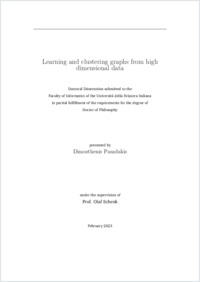Learning and clustering graphs from high dimensional data
- Pasadakis, Dimosthenis ORCID
- Schenk, Olaf (Degree supervisor) ORCID
- 2023
PhD: Università della Svizzera italiana
l1-regularization
Gaussian Markov random fields
M-matrices
Precision matrix estimation
Graph p-Laplacian
Spectral graph clustering
English
Estimating the graphical structures of high dimensional data and identifying the presence of clusters in them are ubiquitous tasks in every scientific domain that deals with interacting or interconnected variables. We participate in the advance of these research fields with efficient and accurate algorithms that learn and cluster graphs. Initially, we contribute in the development of a performant precision matrix estimation routine based on the sparse quadratic approximation of the l1 regularized Gaussian maximum likelihood method. The proposed method exploits the presence of block structure in the underlying computations, and is suitable for datasets characterized by reduced sparsity. Motivated by its effectiveness in high dimensional problems, we extend the capabilities of this method to the retrieval of graphs of only non-negatively correlated variables, and introduce two algorithms for sparse M-matrix estimation. The first one is based on consecutive precision matrix estimations, while the second one performs constrained optimization for the retrieval of the final graphical structure. Finally, we present a nonlinear reformulation of direct multiway spectral clustering that is formulated as an unconstrained minimization problem. Our method promotes sharp indicator vectors that correspond to optimal graph cuts and improved clustering assignments. The advantages of all introduced algorithms are showcased in a series of comparative tests with the current state-of-the-art on artificial datasets, and their real-world applicability is demonstrated with numerical experiments on biological, medical, and image data.
- Collections
- Language
-
- English
- Classification
- Computer science and technology
- License
-
License undefined
- Open access status
- green
- Identifiers
-
- NDP-USI 2023INF001
- URN urn:nbn:ch:rero-006-121365
- ARK ark:/12658/srd1324640
- Persistent URL
- https://n2t.net/ark:/12658/srd1324640
Statistics
Document views: 378
File downloads:
- 2023INF001: 339
